Exploring Blindness: Psychological, Social, and Practical Challenges
VerifiedAdded on 2022/11/11
|6
|1590
|232
Essay
AI Summary
This essay delves into the multifaceted psychological and social dimensions of blindness, emphasizing the importance of understanding the mental health challenges faced by individuals with visual impairments, such as anxiety, depression, and post-traumatic stress disorder. It highlights the significance of social support, caregiver roles, and the need for effective interventions to improve the quality of life for the blind. The essay discusses practical considerations, including communication strategies, clothing management, and feeding assistance, while also addressing the importance of fostering social skills and promoting positive interactions within the community. Furthermore, it underscores the need for societal awareness and sensitivity to the unique needs of the blind, advocating for their inclusion and active participation in various aspects of life. The essay draws on various research to support its arguments and stresses the importance of understanding and addressing the psychological and social needs of individuals with visual impairments.
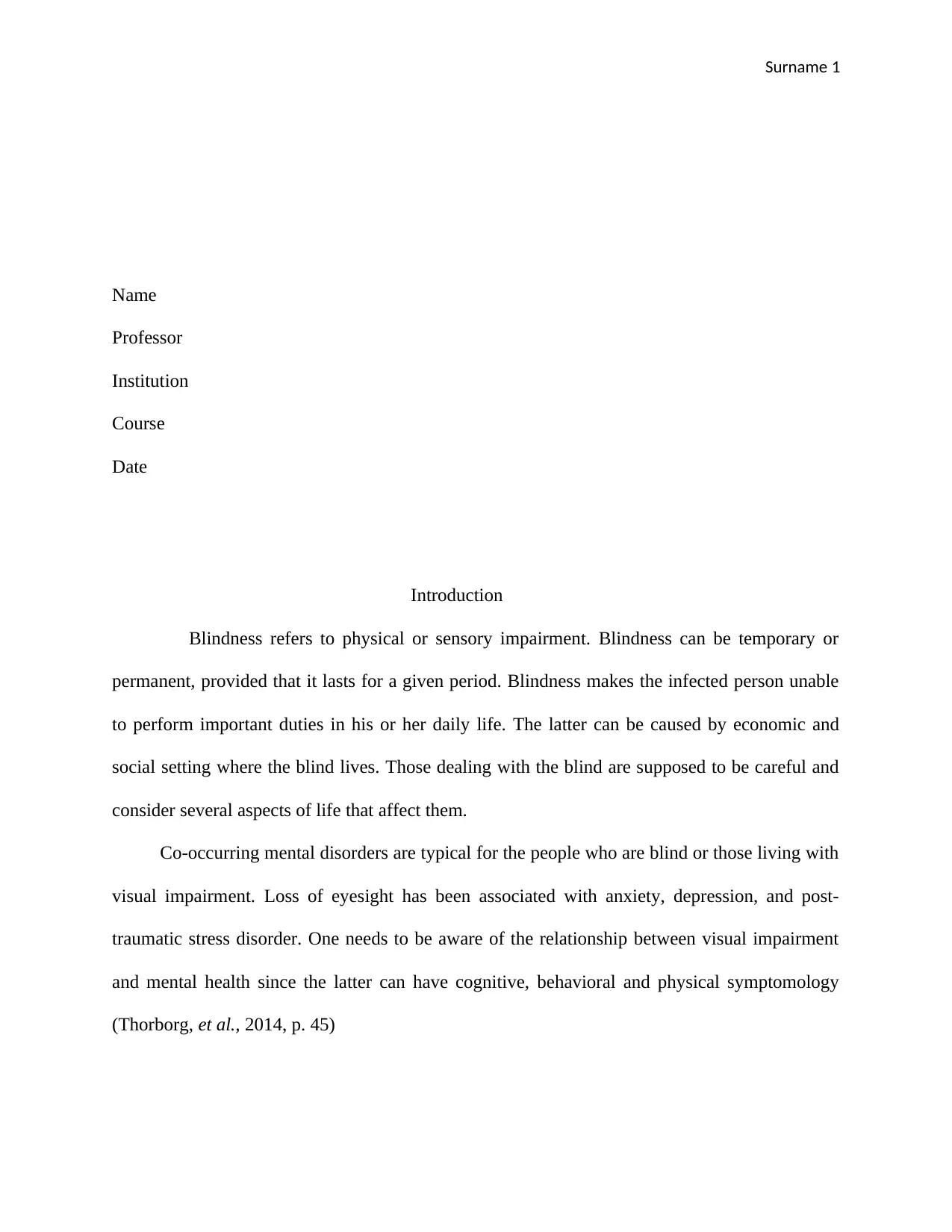
Surname 1
Name
Professor
Institution
Course
Date
Introduction
Blindness refers to physical or sensory impairment. Blindness can be temporary or
permanent, provided that it lasts for a given period. Blindness makes the infected person unable
to perform important duties in his or her daily life. The latter can be caused by economic and
social setting where the blind lives. Those dealing with the blind are supposed to be careful and
consider several aspects of life that affect them.
Co-occurring mental disorders are typical for the people who are blind or those living with
visual impairment. Loss of eyesight has been associated with anxiety, depression, and post-
traumatic stress disorder. One needs to be aware of the relationship between visual impairment
and mental health since the latter can have cognitive, behavioral and physical symptomology
(Thorborg, et al., 2014, p. 45)
Name
Professor
Institution
Course
Date
Introduction
Blindness refers to physical or sensory impairment. Blindness can be temporary or
permanent, provided that it lasts for a given period. Blindness makes the infected person unable
to perform important duties in his or her daily life. The latter can be caused by economic and
social setting where the blind lives. Those dealing with the blind are supposed to be careful and
consider several aspects of life that affect them.
Co-occurring mental disorders are typical for the people who are blind or those living with
visual impairment. Loss of eyesight has been associated with anxiety, depression, and post-
traumatic stress disorder. One needs to be aware of the relationship between visual impairment
and mental health since the latter can have cognitive, behavioral and physical symptomology
(Thorborg, et al., 2014, p. 45)
Paraphrase This Document
Need a fresh take? Get an instant paraphrase of this document with our AI Paraphraser
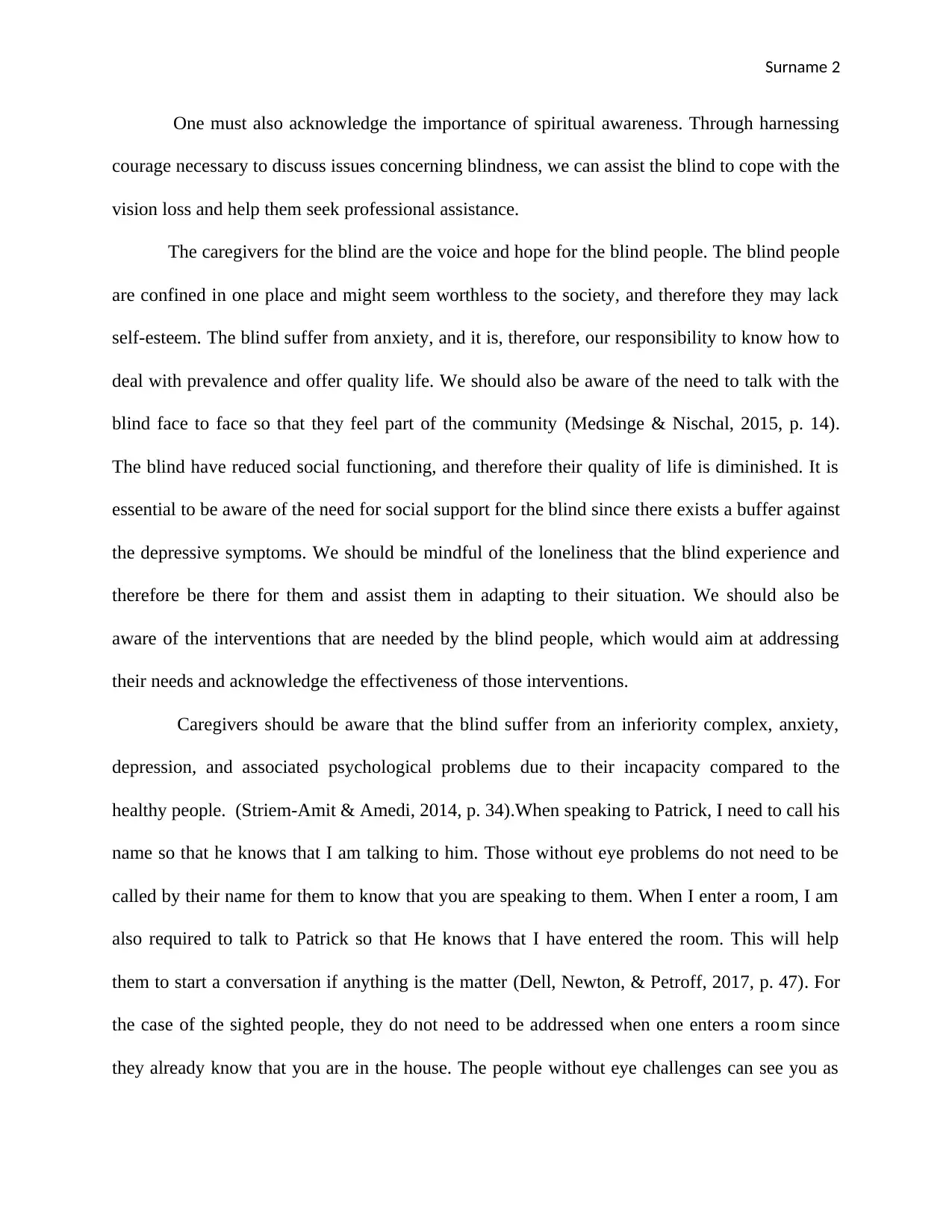
Surname 2
One must also acknowledge the importance of spiritual awareness. Through harnessing
courage necessary to discuss issues concerning blindness, we can assist the blind to cope with the
vision loss and help them seek professional assistance.
The caregivers for the blind are the voice and hope for the blind people. The blind people
are confined in one place and might seem worthless to the society, and therefore they may lack
self-esteem. The blind suffer from anxiety, and it is, therefore, our responsibility to know how to
deal with prevalence and offer quality life. We should also be aware of the need to talk with the
blind face to face so that they feel part of the community (Medsinge & Nischal, 2015, p. 14).
The blind have reduced social functioning, and therefore their quality of life is diminished. It is
essential to be aware of the need for social support for the blind since there exists a buffer against
the depressive symptoms. We should be mindful of the loneliness that the blind experience and
therefore be there for them and assist them in adapting to their situation. We should also be
aware of the interventions that are needed by the blind people, which would aim at addressing
their needs and acknowledge the effectiveness of those interventions.
Caregivers should be aware that the blind suffer from an inferiority complex, anxiety,
depression, and associated psychological problems due to their incapacity compared to the
healthy people. (Striem-Amit & Amedi, 2014, p. 34).When speaking to Patrick, I need to call his
name so that he knows that I am talking to him. Those without eye problems do not need to be
called by their name for them to know that you are speaking to them. When I enter a room, I am
also required to talk to Patrick so that He knows that I have entered the room. This will help
them to start a conversation if anything is the matter (Dell, Newton, & Petroff, 2017, p. 47). For
the case of the sighted people, they do not need to be addressed when one enters a room since
they already know that you are in the house. The people without eye challenges can see you as
One must also acknowledge the importance of spiritual awareness. Through harnessing
courage necessary to discuss issues concerning blindness, we can assist the blind to cope with the
vision loss and help them seek professional assistance.
The caregivers for the blind are the voice and hope for the blind people. The blind people
are confined in one place and might seem worthless to the society, and therefore they may lack
self-esteem. The blind suffer from anxiety, and it is, therefore, our responsibility to know how to
deal with prevalence and offer quality life. We should also be aware of the need to talk with the
blind face to face so that they feel part of the community (Medsinge & Nischal, 2015, p. 14).
The blind have reduced social functioning, and therefore their quality of life is diminished. It is
essential to be aware of the need for social support for the blind since there exists a buffer against
the depressive symptoms. We should be mindful of the loneliness that the blind experience and
therefore be there for them and assist them in adapting to their situation. We should also be
aware of the interventions that are needed by the blind people, which would aim at addressing
their needs and acknowledge the effectiveness of those interventions.
Caregivers should be aware that the blind suffer from an inferiority complex, anxiety,
depression, and associated psychological problems due to their incapacity compared to the
healthy people. (Striem-Amit & Amedi, 2014, p. 34).When speaking to Patrick, I need to call his
name so that he knows that I am talking to him. Those without eye problems do not need to be
called by their name for them to know that you are speaking to them. When I enter a room, I am
also required to talk to Patrick so that He knows that I have entered the room. This will help
them to start a conversation if anything is the matter (Dell, Newton, & Petroff, 2017, p. 47). For
the case of the sighted people, they do not need to be addressed when one enters a room since
they already know that you are in the house. The people without eye challenges can see you as
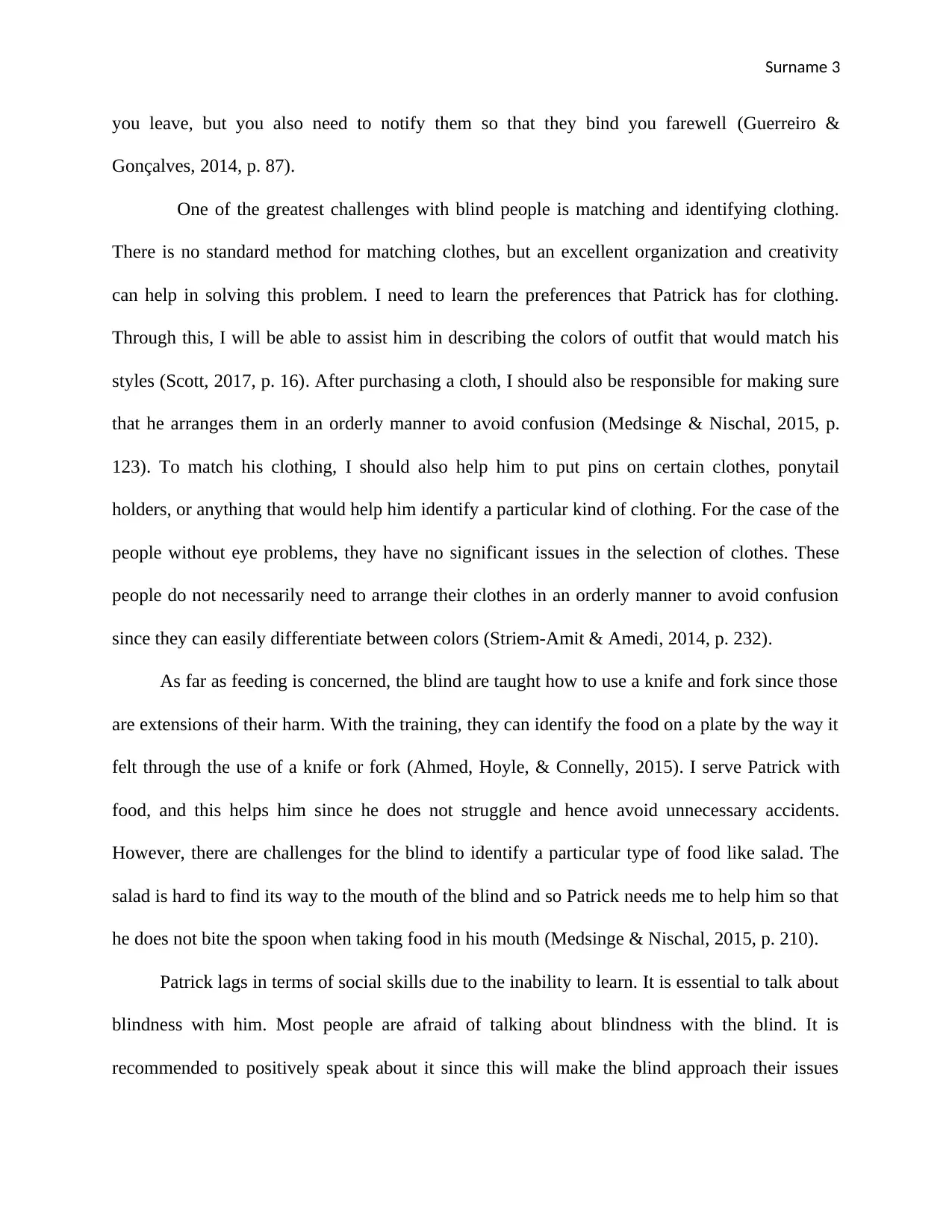
Surname 3
you leave, but you also need to notify them so that they bind you farewell (Guerreiro &
Gonçalves, 2014, p. 87).
One of the greatest challenges with blind people is matching and identifying clothing.
There is no standard method for matching clothes, but an excellent organization and creativity
can help in solving this problem. I need to learn the preferences that Patrick has for clothing.
Through this, I will be able to assist him in describing the colors of outfit that would match his
styles (Scott, 2017, p. 16). After purchasing a cloth, I should also be responsible for making sure
that he arranges them in an orderly manner to avoid confusion (Medsinge & Nischal, 2015, p.
123). To match his clothing, I should also help him to put pins on certain clothes, ponytail
holders, or anything that would help him identify a particular kind of clothing. For the case of the
people without eye problems, they have no significant issues in the selection of clothes. These
people do not necessarily need to arrange their clothes in an orderly manner to avoid confusion
since they can easily differentiate between colors (Striem-Amit & Amedi, 2014, p. 232).
As far as feeding is concerned, the blind are taught how to use a knife and fork since those
are extensions of their harm. With the training, they can identify the food on a plate by the way it
felt through the use of a knife or fork (Ahmed, Hoyle, & Connelly, 2015). I serve Patrick with
food, and this helps him since he does not struggle and hence avoid unnecessary accidents.
However, there are challenges for the blind to identify a particular type of food like salad. The
salad is hard to find its way to the mouth of the blind and so Patrick needs me to help him so that
he does not bite the spoon when taking food in his mouth (Medsinge & Nischal, 2015, p. 210).
Patrick lags in terms of social skills due to the inability to learn. It is essential to talk about
blindness with him. Most people are afraid of talking about blindness with the blind. It is
recommended to positively speak about it since this will make the blind approach their issues
you leave, but you also need to notify them so that they bind you farewell (Guerreiro &
Gonçalves, 2014, p. 87).
One of the greatest challenges with blind people is matching and identifying clothing.
There is no standard method for matching clothes, but an excellent organization and creativity
can help in solving this problem. I need to learn the preferences that Patrick has for clothing.
Through this, I will be able to assist him in describing the colors of outfit that would match his
styles (Scott, 2017, p. 16). After purchasing a cloth, I should also be responsible for making sure
that he arranges them in an orderly manner to avoid confusion (Medsinge & Nischal, 2015, p.
123). To match his clothing, I should also help him to put pins on certain clothes, ponytail
holders, or anything that would help him identify a particular kind of clothing. For the case of the
people without eye problems, they have no significant issues in the selection of clothes. These
people do not necessarily need to arrange their clothes in an orderly manner to avoid confusion
since they can easily differentiate between colors (Striem-Amit & Amedi, 2014, p. 232).
As far as feeding is concerned, the blind are taught how to use a knife and fork since those
are extensions of their harm. With the training, they can identify the food on a plate by the way it
felt through the use of a knife or fork (Ahmed, Hoyle, & Connelly, 2015). I serve Patrick with
food, and this helps him since he does not struggle and hence avoid unnecessary accidents.
However, there are challenges for the blind to identify a particular type of food like salad. The
salad is hard to find its way to the mouth of the blind and so Patrick needs me to help him so that
he does not bite the spoon when taking food in his mouth (Medsinge & Nischal, 2015, p. 210).
Patrick lags in terms of social skills due to the inability to learn. It is essential to talk about
blindness with him. Most people are afraid of talking about blindness with the blind. It is
recommended to positively speak about it since this will make the blind approach their issues
⊘ This is a preview!⊘
Do you want full access?
Subscribe today to unlock all pages.

Trusted by 1+ million students worldwide
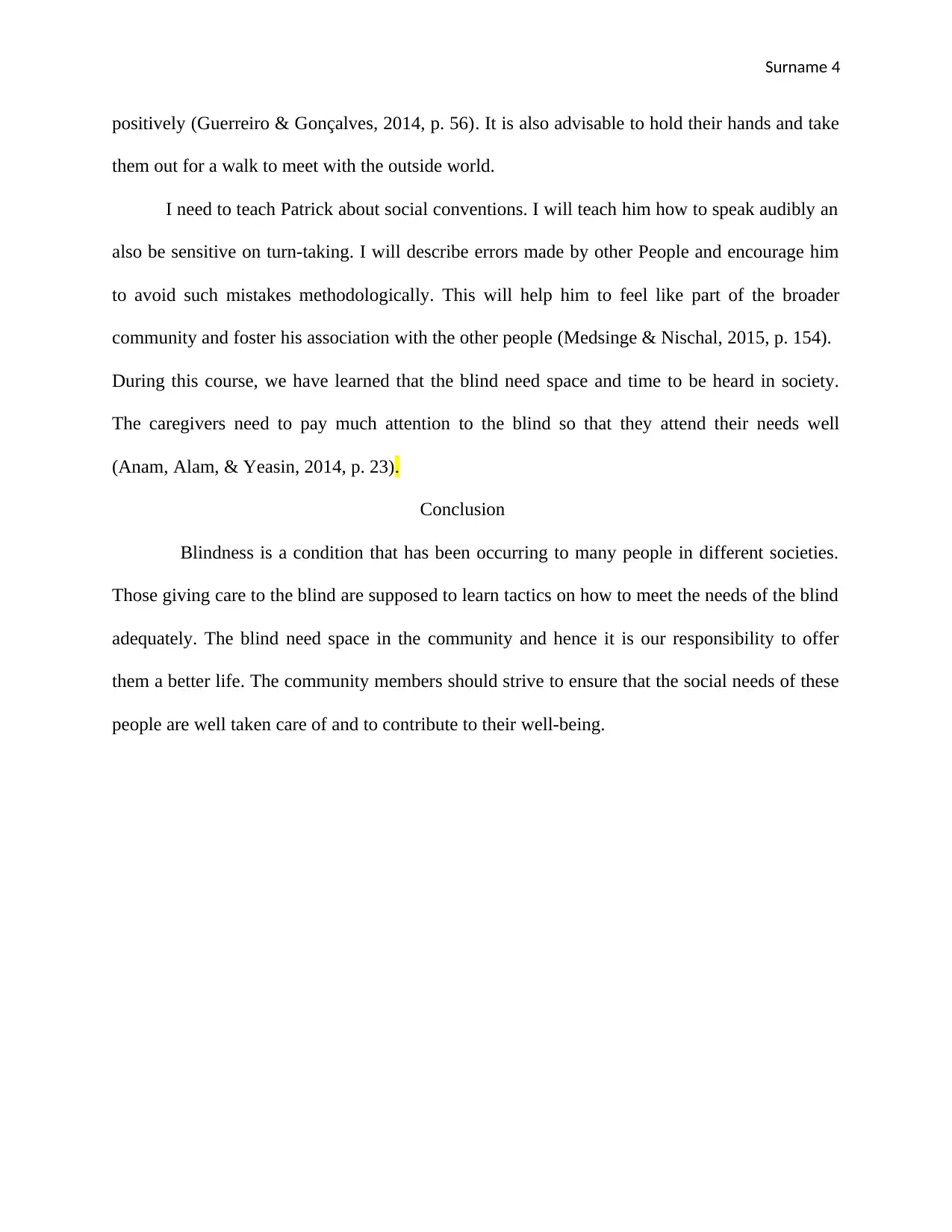
Surname 4
positively (Guerreiro & Gonçalves, 2014, p. 56). It is also advisable to hold their hands and take
them out for a walk to meet with the outside world.
I need to teach Patrick about social conventions. I will teach him how to speak audibly an
also be sensitive on turn-taking. I will describe errors made by other People and encourage him
to avoid such mistakes methodologically. This will help him to feel like part of the broader
community and foster his association with the other people (Medsinge & Nischal, 2015, p. 154).
During this course, we have learned that the blind need space and time to be heard in society.
The caregivers need to pay much attention to the blind so that they attend their needs well
(Anam, Alam, & Yeasin, 2014, p. 23).
Conclusion
Blindness is a condition that has been occurring to many people in different societies.
Those giving care to the blind are supposed to learn tactics on how to meet the needs of the blind
adequately. The blind need space in the community and hence it is our responsibility to offer
them a better life. The community members should strive to ensure that the social needs of these
people are well taken care of and to contribute to their well-being.
positively (Guerreiro & Gonçalves, 2014, p. 56). It is also advisable to hold their hands and take
them out for a walk to meet with the outside world.
I need to teach Patrick about social conventions. I will teach him how to speak audibly an
also be sensitive on turn-taking. I will describe errors made by other People and encourage him
to avoid such mistakes methodologically. This will help him to feel like part of the broader
community and foster his association with the other people (Medsinge & Nischal, 2015, p. 154).
During this course, we have learned that the blind need space and time to be heard in society.
The caregivers need to pay much attention to the blind so that they attend their needs well
(Anam, Alam, & Yeasin, 2014, p. 23).
Conclusion
Blindness is a condition that has been occurring to many people in different societies.
Those giving care to the blind are supposed to learn tactics on how to meet the needs of the blind
adequately. The blind need space in the community and hence it is our responsibility to offer
them a better life. The community members should strive to ensure that the social needs of these
people are well taken care of and to contribute to their well-being.
Paraphrase This Document
Need a fresh take? Get an instant paraphrase of this document with our AI Paraphraser
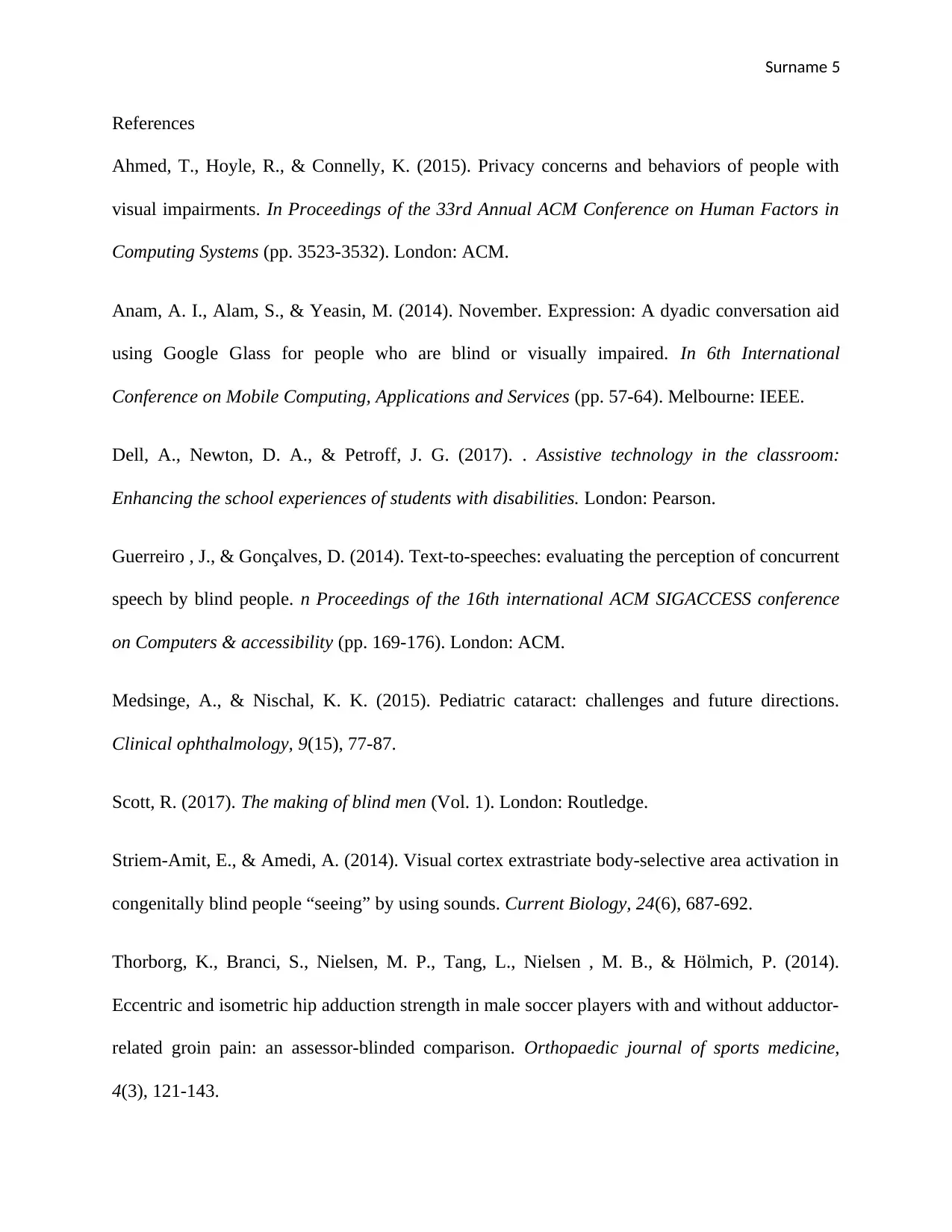
Surname 5
References
Ahmed, T., Hoyle, R., & Connelly, K. (2015). Privacy concerns and behaviors of people with
visual impairments. In Proceedings of the 33rd Annual ACM Conference on Human Factors in
Computing Systems (pp. 3523-3532). London: ACM.
Anam, A. I., Alam, S., & Yeasin, M. (2014). November. Expression: A dyadic conversation aid
using Google Glass for people who are blind or visually impaired. In 6th International
Conference on Mobile Computing, Applications and Services (pp. 57-64). Melbourne: IEEE.
Dell, A., Newton, D. A., & Petroff, J. G. (2017). . Assistive technology in the classroom:
Enhancing the school experiences of students with disabilities. London: Pearson.
Guerreiro , J., & Gonçalves, D. (2014). Text-to-speeches: evaluating the perception of concurrent
speech by blind people. n Proceedings of the 16th international ACM SIGACCESS conference
on Computers & accessibility (pp. 169-176). London: ACM.
Medsinge, A., & Nischal, K. K. (2015). Pediatric cataract: challenges and future directions.
Clinical ophthalmology, 9(15), 77-87.
Scott, R. (2017). The making of blind men (Vol. 1). London: Routledge.
Striem-Amit, E., & Amedi, A. (2014). Visual cortex extrastriate body-selective area activation in
congenitally blind people “seeing” by using sounds. Current Biology, 24(6), 687-692.
Thorborg, K., Branci, S., Nielsen, M. P., Tang, L., Nielsen , M. B., & Hölmich, P. (2014).
Eccentric and isometric hip adduction strength in male soccer players with and without adductor-
related groin pain: an assessor-blinded comparison. Orthopaedic journal of sports medicine,
4(3), 121-143.
References
Ahmed, T., Hoyle, R., & Connelly, K. (2015). Privacy concerns and behaviors of people with
visual impairments. In Proceedings of the 33rd Annual ACM Conference on Human Factors in
Computing Systems (pp. 3523-3532). London: ACM.
Anam, A. I., Alam, S., & Yeasin, M. (2014). November. Expression: A dyadic conversation aid
using Google Glass for people who are blind or visually impaired. In 6th International
Conference on Mobile Computing, Applications and Services (pp. 57-64). Melbourne: IEEE.
Dell, A., Newton, D. A., & Petroff, J. G. (2017). . Assistive technology in the classroom:
Enhancing the school experiences of students with disabilities. London: Pearson.
Guerreiro , J., & Gonçalves, D. (2014). Text-to-speeches: evaluating the perception of concurrent
speech by blind people. n Proceedings of the 16th international ACM SIGACCESS conference
on Computers & accessibility (pp. 169-176). London: ACM.
Medsinge, A., & Nischal, K. K. (2015). Pediatric cataract: challenges and future directions.
Clinical ophthalmology, 9(15), 77-87.
Scott, R. (2017). The making of blind men (Vol. 1). London: Routledge.
Striem-Amit, E., & Amedi, A. (2014). Visual cortex extrastriate body-selective area activation in
congenitally blind people “seeing” by using sounds. Current Biology, 24(6), 687-692.
Thorborg, K., Branci, S., Nielsen, M. P., Tang, L., Nielsen , M. B., & Hölmich, P. (2014).
Eccentric and isometric hip adduction strength in male soccer players with and without adductor-
related groin pain: an assessor-blinded comparison. Orthopaedic journal of sports medicine,
4(3), 121-143.

Surname 6
⊘ This is a preview!⊘
Do you want full access?
Subscribe today to unlock all pages.

Trusted by 1+ million students worldwide
1 out of 6
Related Documents
Your All-in-One AI-Powered Toolkit for Academic Success.
+13062052269
info@desklib.com
Available 24*7 on WhatsApp / Email
![[object Object]](/_next/static/media/star-bottom.7253800d.svg)
Unlock your academic potential
Copyright © 2020–2025 A2Z Services. All Rights Reserved. Developed and managed by ZUCOL.





